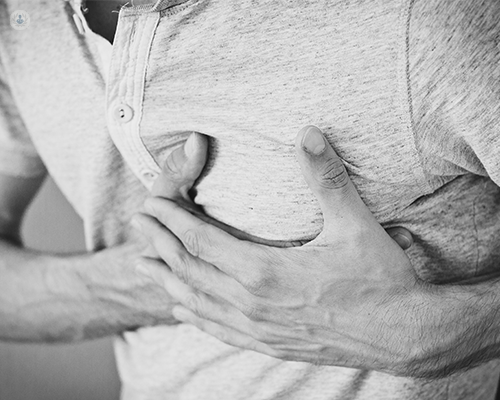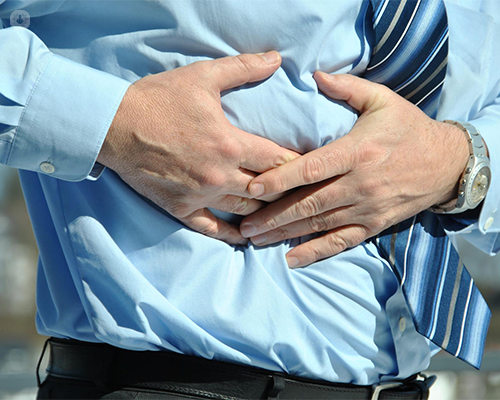Chest pain
What is chest pain?
Pain in the chest is a pain in the front part of the chest, located between the neck and the upper part of the abdomen, which can be a symptom of various cardiac, respiratory, infectious, nervous pathologies, and osteoarticular or muscular injuries. Sometimes, chest pain may spread to the neck, abdomen, or back.

It is a very common pain and may cause different intensities depending on its cause or origin.
What is the prognosis of the disease?
Chest pain may be due, in severe cases, to serious and urgent medical conditions as heart attack or heart failure, which are life threatening conditions.
Despite the feeling of strong chest pain, most of the time the causes are not dangerous. But since there are many possible causes of chest pain, it is essential to visit a cardiologist or pulmonologist quickly, to receive immediate treatment if necessary.
What are symptoms of chest pain?
The most common symptoms of chest pain are a stabbing pain and compressed feeling, although they usually vary depending on the affected organs or tissues:
- coronary thoracic pain: when the causes are related to the heart, the pain usually involves a feeling of heaviness, and spreads to the left arm and neck. This type of pain can cause as well other symptoms such as nausea and vomiting, sweating, and shortness of breath.
- pleuropulmonary chest pain: chest pain caused by lung or respiratory problems is located towards the sides of the chest and intensifies when breathing or coughing.
- pericarditic chest pain: a stabbing pain and oppressive feeling, in the centre of the chest, that increases while breathing.
- gastrointestinal or esophageal chest pain: this type of chest pain is usually caused by a hiatus hernia or oesophageal problems, and is a sharp pain in the area of the sternum, which can reach the throat.
- osteomuscular thoracic pain : a pain caused by injuries, fractures, or muscular tears located in the affected area and increases with the movement of the torso.
- neuritic chest pain: this pain is often caused by the varicella zoster virus and causes a burning pain, usually affects one side of the chest.
- chest pain of nervous or psychological origin: characterised by a sharp pain, like pins in the centre of the chest.

What are medical tests for chest pain?
Due to the multiple causes that can cause chest pain, it is sometimes a challenge for the specialist to establish a diagnosis. For this reason, the clinical history of the patient will be essential to be able to understand their symptoms, previous illnesses, and family medical records.
Once the patient's medical history is analysed, and if there is no clear traumatic cause, a chest x-ray and an electrocardiogram will be required to rule out other serious diseases which could lead to risks such as a heart attack.
Depending on the results of these tests, more investigations may be required, such as a coronary CT scan, pulmonary scintigraphy, a Holter monitor, or digestive study.
What are the causes of chest pain?
There are multiple causes of chest pain, depending on the organs affected:
- acute myocardial infarction (heart attack)
- angina
- heart failure
- pericarditis
- respiratory infections, such as influenza or pneumonia
- digestive problems such as hiatus hernia, oesophageal rupture, or oesophageal spasms
- pulmonary diseases such as pleurisy, lung tumors, or pneumothorax
- mental illnesses, such as a panic attack
- muscle and bone problems such as fractures, tears, and trauma
What is the difference between left side vs. right side chest pain?
Chest pain on the left side is usually associated with issues regarding the heart. If there is pain on the right side, it could indicate:
- lung cancer
- a muscle strain
- bruised or broken rib
- gall bladder, liver, pancreas, or spleen issues
- issues with the lungs
- inflammatory issues (such as costochondritis)
- acid reflux
- other digestive issues (IBS, GORD, heartburn)
- an infection (i.e. pneumonia)
- a blood clot in the lung
- stress or anxiety
- other conditions that are not related to the heart
Chest pain that usually doesn't concern the heart can be associated with: a sour or bad taste in your mouth; difficulty swallowing; pain that gets worse when breathing; pain persisting for many hours; pain that gets worse or better when changing positions; or tenderness when pushing on your chest.
As right side chest pain rarely means there is a problem with the heart, it does not mean that it is not something serious. It is important to know exactly where the pain is being felt when you talk to your doctor so they can make a quick and correct diagnosis. If you have sudden and severe symptoms, seek medical attention immediately.

Can chest pain be prevented?
Chest pain can be prevented if the underlying cause is treated. This is why a visit to a medical specialist is important – making the correct diagnosis of the problem is the first step to effective treatment and future prevention. However, there are precautions that can be taken to reduce chances of having chest pain, including:
- a healthy diet
- avoid saturated fats
- managing current health conditions
- maintaining healthy weight
- exercising regularly
- stopping smoking
- limiting alcohol intake
How is chest pain treated?
Treatment for chest pain depends on the original cause:
- In the case of angina, vasodilators may be prescribed, or an angioplasty may be performed to widen the blood vessels.
- Pneumonia is generally treated with antibiotics.
- Digestive problems can sometimes be treated with antiacids.
- Some cardiovascular issues may require more invasive surgery.
When should you seek a doctor?
If the chest pain comes and goes or goes away quickly, it is still important to see a GP to be certain that there is no serious underlying cause.
Chest pain that comes on quickly and severely or you think you may be having a heart attack, seek medical attention immediately. Do not ignore symptoms of something serious. If you are not sure, it is better to get the advice from a medical professional as soon as possible. In the case that an ambulance cannot reach you, have someone drive you to the emergency or urgent care.
What can increase the risk of chest pain?
Common risk factors that increase the chances of having chest pain include:
- older age
- smoking
- high blood pressure
- diabetes
- high cholesterol
- being overweight
- family history of angina or heart attacks under 60 years old
What specialist treats chest pain?
As chest pain is susceptible to several causes, the treatment of chest pain may be handled by a number of specialists, such as a cardiologist, pulmonologist, gastroenterologist, or psychologist.
At first, when the onset of symptoms that cause pain are unknown, it is best to visit your GP, who will study your medical history and symptoms then refer you to the right specialist to treat your particular case.
This website uses our own and third-party Cookies to compile information with the aim of improving our services, to show you advertising related to your preferences as well analysing your browsing habits. You can change your settings HERE.